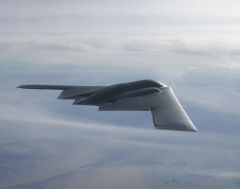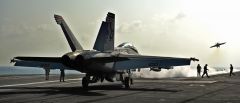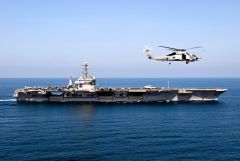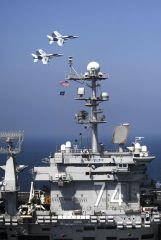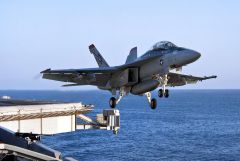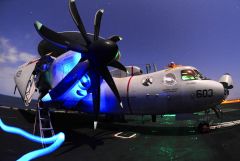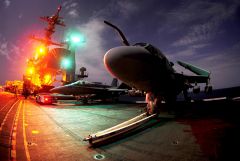-
Numero contenuti
5669 -
Iscritto il
-
Ultima visita
-
Giorni Vinti
44
Tutti i contenuti di -{-Legolas-}-
-
Un'aggiornamento sulla gara per un nuovo caccia per le forze di difesa giapponesi.
-
"The Eurofighter has fallen behind in the race to become Japan's next-generation air-defence fighter. " "Even before March 11 there were many factors in favour of the F-35, but since then that national security relationship between the two governments has become much closer," one analyst with knowledge of the bidding told The Daily Telegraph. Queste in pratica le affermazioni apparse sul Telegraph, che secondo la logica degli aiuti avuti dagli Stati Uniti dopo lo Tsunami, e le esigenze della JASDF di un "guardiano stealth" (ma secondo me, di un penetratore stealth) fanno pendere la bilancia del concorso per un nuovo caccia per la forza aerea, a favore dello F-35. Fonte Telegraph
-

Afghanistan - Topic ufficiale
-{-Legolas-}- ha risposto a Thunderalex nella discussione Discussioni a tema
Il 13 Luglio 2008, a Wanat si è combattuta un'aspra battaglia che ha lasciato molti punti interrogativi aperti, sul luogo in cui l'avamposto è stato posizionato, una vallata cieca e sovrastata da alture, e sulla morte del giovane Lt. Jonathan Brostrom, la cui famiglia ha condotto per anni un'intensa ricerca della verità su quanto accaduto dopo la morte del loro congiunto. Questo articolo sul Vanity Fair è un resoconto della Battaglia di Wanat, in cui circa 200 talebani attaccarono l'avamposto, in cui perirono 9 soldati americani e 27 furono i feriti. L'articolo su Vanity Fair Le slide interattive -
Ok, basta Off Topic però per cortesia. Grazie a tutti.
-

Afghanistan - Topic ufficiale
-{-Legolas-}- ha risposto a Thunderalex nella discussione Discussioni a tema
Un interessante documentario video della HBO sulla battaglia di Marjah, febbraio 2010. HBO: The Battle for Marjah -

Cade aereo Red Arrows
-{-Legolas-}- ha risposto a francesco72 nella discussione Pattuglie Acrobatiche
Effettivamente sembra proprio che deve essere così, anzi l'Mk-2 che se non sbaglio di nuovo equipaggia gli Hawk, era un'evoluzione del modello precedente che aveva proprio questi problemi col paracadute. Mk. 2 Experience with the manually operated seats had shown that a number of fatalities had occurred, due to unconsciousness after ejection, inaction due to circumstantial stress, or lack of time to carry out the necessary manual operations when ejecting at low altitudes. Accordingly, effort was concentrated on producing a simple, yet effective, fully automatic ejection seat, capable of being produced in quantity, reliable in service, and designed to permit the retrospective conversion of most of the existing manually operated seats already installed in Service aircraft. In the design of the first automatic seat, it was decided to house the personal parachute in a container in the back of the seat and the dinghy pack in the seat pan, to facilitate the use of the drogue to effect deployment of the parachute. It was also necessary to devise some means of disconnecting the drogue from the seat at the correct time and transferring its pull to the parachute, and simultaneously a means of releasing the occupant complete with his parachute and dinghy pack from the seat. On the Mk. 1 seats, the drogue had been attached to the top of the seat by a solid shackle. This was now replaced by a "Scissor Shackle", capable of being opened automatically at a pre-determined time. Fonte Martin Baker Comunuqe quello che intendevo io, è che non vorrei che il pilota abbia operato su qualcosa che durante la check list si deve controllare, e che abbia causato l'eiezione. Infatti leggendo questo manuale sullo Mk-2, che però è installato sui Camberra, quindi da prendere con le pinze, si vede a pag. 14 scritto: "Reach upwards and check that the face screen firing handle is within easy reach: DO NOT PULL!" Comunque anche avesse sbagliato, il paracadute doveva aprirsi, non ci piove. -

Specifiche delle versioni del PANAVIA Tornado
-{-Legolas-}- ha risposto a Unholy nella discussione Bombardieri & Attacco al suolo
Come dicevamo nella discussione sull'Operazione Odissey Down, il costo orario del Tornado in quel frangente è stato di circa 15.000 £ l'ora. Vai al link della discussione -

UH-60 Black Hawk - Discussione Ufficiale
-{-Legolas-}- ha risposto a Jack89 nella discussione Elicotteri
Forse questo non è nemmeno il modello di elicottero più furtivo in essere nell'arsenale USA. Lo "Stealth Hawk" come ormai è noto, fa sue le prestazioni di riduzione della traccia radar, e delle segnature acustiche e infrarosse, ma se Chuck Pfarrer dice il vero nel suo libro "SEAL Target Jeronimo" (nella sezione dedicata ai libri, c'è un post sul libro appena uscito), ci sarebbe un "Gen-3" o anche chiamato "Ghost Hawk", che spinge ancora avanti le doti di furtività oltre a quello caduto in Pakistan, di cui il Pentagono ovviamente non lascierebbe trapelare nulla essendo consegnato al più alto grado di segretezza. Fonte: Danger Room -

Cade aereo Red Arrows
-{-Legolas-}- ha risposto a francesco72 nella discussione Pattuglie Acrobatiche
Il nostro pensiero corre alla memoria del pilota morto, e ai suoi cari. Attendiamo il rapporto dell'indagine tecnica, a questo punto può essere stato un guasto o una manovra errata del pilota. -

Afghanistan - Topic ufficiale
-{-Legolas-}- ha risposto a Thunderalex nella discussione Discussioni a tema
Cito testualmente: "Posso solo dire che ho potuto osservare il lavoro e la professionalità di quella Task Force 45 e credo che gli italiani sarebbero orgogliosi dei loro soldati», dichiarò McChrystal nel marzo dell'anno scorso." -
A B-2 Spirit flies to the North Pole Oct. 27, 2011, on a test mission from Edwards Air Force Base, Calif. The polar flight helped ensure that the B-2 maintains its global combat power capability in all environments with new computers for future growth and sustained contributions to the greater Air Force mission. (U.S. Air Force photo/Bobbi Zapka)
© © www.af.mil
-
Per le dimensioni dell'impegno nazionale nel programma F-35, non conviene buttare via l'intero progetto. Sarebbe meglio per le casse dello Stato combattere efficacemente l'evasione fiscale e la corruzione, non tagliare i progetti più importanti pensando di risparmiare qualche decina di miliardi, perchè se non ci sono fondi per l'F-35, non ce ne saranno nemmeno per Typhoon o Super Hornet.
-
-
An MH-60R Sea Hawk helicopter assigned flies near the aircraft carrier USS John C. Stennis in the Arabian Sea, Oct. 24, 2011. The Stennis is deployed to the U.S. 5th Fleet area of responsibility conducting maritime security operations and support missions as part of Operations Enduring Freedom and New Dawn. U.S. Navy photo by Petty Officer 3rd Class Benjamin Crossley
© © www.defense.gov
-
Umberto il tuo link è rotto. Prova anche tu.
-
E' incredibile quello che riescono a fare i giapponesi con l'elettronica. E' stato presentato lo Spherical Flying Machine che appartiene al Ministero di Difesa giapponese. Per 1400$ hanno sviluppato un drone che vola come un UFO e atterra ovunque. All'occorrenza rotola come Fido. Fonte: Popsci.com
-
L'F-22 torna a volare. Siamo lontani da una soluzione, ma la flotta continuerà ad essere monitorata per raccogliere dati utili alla risoluzione del problema.
-
Senza contare il risparmio industriale e logistico, che deriva dallo avere un velivolo con l'80% e oltre di componenti in comune.
-
-

Abbattuto Chinook Usa. Strage di Neavy Seals
-{-Legolas-}- ha risposto a Devildic nella discussione News Aviazione
Vi rendo noto l'estratto del rapporto dell'abbattimento dello Chinook. -

SAAB JAS-39 Gripen - discussione ufficiale
-{-Legolas-}- ha risposto a maverik1 nella discussione Caccia
Piccolo e leggero, direi che sia tagliato per fare il mestiere del marinaio. Avanti col Sea Griphen allora. Indian Defence News -
-
-
A U.S. Navy EA-6B Prowler aircraft sits on the flight deck while sailors prepare for an arrested landing aboard the USS John C. Stennis in the Arabian Sea, Oct. 11, 2011. The John C. Stennis is deployed to the U.S. 5th Fleet area of responsibility conducting maritime security operations and support missions as part of operations Enduring Freedom and New Dawn. U.S. Navy photo by Petty Officer 2nd Class Walter M. Wayman
© © www.defense.gov
-

Libia - Discussione Ufficiale
-{-Legolas-}- ha risposto a °Delta nella discussione Discussioni a tema
Gaddafi's final hours: Nato and the SAS helped rebels drive hunted leader into endgame in a desert drain As the sun rose over the shell of Sirte on Thursday, Ben Farmer, the only British newspaper journalist left in the city, found it was immediately apparent that something had changed. The drain where Muammar Gaddafi was hiding before he was captured in Sirte 'This is the place where the rat Gaddafi was hiding,' said one piece of graffiti sprayed onto the concrete wall of the drain Photo: REUTERS Ben Farmer By Ben Farmer, Sirte 8:23PM BST 22 Oct 2011 Utterly ravaged by months of bombardments, Sirte was a skeleton of a city – a place without food, water or light; a city without citizens. Its streets were turned into rivers by burst pipes, as fighters battled through waist-high swathes of mud brown water, street by bloody street. But as the sun rose over the shell of Sirte on Thursday, it was immediately apparent that something had changed. I had arrived at the rebel position in the western suburb of Zafran in anticipation of another massed assault into District Two – the final pocket where Gaddafi loyalists had been holding out. Rebels from Misurata had told me the day before to be ready early to witness a home-made armoured battering ram, and their few tanks spearhead what they boasted would be a decisive thrust into the remaining bastion of defenders. Little did we know, at that point, that Gaddafi had also decided that it was time for the endgame. The embattled leader had been forced to retreat to an area 1000 yards by 500 yards, and was desperately moving from house to house, trying to evade capture. Related Articles Seeing the noose tighten to strangulation point, he had ordered his men on Wednesday night to pack a convoy of 75 vehicles in preparation for a move towards Wadi Jarif, 25 miles away. "We decided to leave Sirte and go to Jarif because it had become unsafe," said Mansour Daou, Gaddafi's cousin and bodyguard. The Colonel, he said, was "tense, but not afraid". But Gaddafi, like us, was unaware of the chain reaction which he had sparked by making that dash for freedom. More than 6,000 miles away, deep in the lunar landscape of the Nevada desert, American specialists trained to their computer screens spotted unusual activity at around 7.30am in District Two. From their windowless bunker, lit by constantly flickering computer screens, the analysts directed their unmanned Predator drones to zoom in on the convoy as it picked up speed and headed west. Nato's eyes were suddenly trained on Gaddafi's convoy. Yet at that moment, I was ignorant of that, and caught up in the midst of a chaotic scene at the crossroads by a scarred television station building, which was the planned launch point for the offensive into District Two. The battle was taking an unexpected turn. At 8am the air was thick with the crackle of bullets and shots were hitting the street corner – from directions which had been cleared of loyalists for days. In the street beside the TV station – which should have been protected from loyalist marksmen toward the east – fighters were running bent double and crouching in the doorways of burnt-out houses as they tried to assess who was shooting at them. "The plan has changed. Some loyalists have broken out overnight," one young fighter told me hurriedly. "They have got around the back of us." Unknown to us then – and what would not become clear for hours afterwards – was that among those who had broken out a few hundred yards from us was none other than Col Muammar Gaddafi. The confusion I was witnessing was not another small skirmish, but the final chaotic moments of the Libyan despot's rule. He and his inner circle had tried to punch westward out of the shattered city into open countryside in a column of vehicles. But it was a gamble that ultimately would not allow him to escape the fate suffered by so many of his opponents during his 42 years of rule. High above Sirte the heavily-armed American USMQ1 Predator drones, which are piloted by satellite link and can provide surveillance or fire missiles in all weather, day and night, had been circling. The aircraft, which can remain "on station" for up to 18 hours, were being remotely flown from Creech air force base in Nevada. One of the predator pilots had now received permission to attack the fleeing convoy. Around 40 miles off the Libyan coast a Nato AWAC early-warning surveillance aircraft, flying over the Mediterranean, took control of the battle and warned two French jets that a loyalist convoy was attempting to leave Sirte. As the convoy sped west, a Hellfire missile was fired from the Predator and destroyed the first vehicle in the convoy. By now, the NTC troops had realised that the loyalists were escaping and a small number of lightly armed rebels began to give chase. To me it seemed like a wild, chaotic situation. But we now know that it had, in fact, been foreseen by the British SAS and their special forces allies, who were advising the NTC forces. British military sources have told The Sunday Telegraph that small teams of SAS soldiers on the ground in Sirte, armed but under strict orders not to get involved, had warned them throughout the siege to be alert to the fleeing of loyalists. Assisted by other special forces – in particular the Qataris, with whom the SAS have a long relationship dating back 20 years – the SAS tried to impress on the Libyans the need to cover all escape routes. But despite the advice, the breakout seems to have taken the rebels on the Zafran front completely by surprise. In the previous two weeks I had repeatedly seen the militiamen fail to hold forward positions at night as they fell back to their encampments. Again and again loyalists had used cover of darkness to surprise the militiamen and manoeuvre into new firing positions. Once more their surveillance was lax, and one rebel fighter confessed to me that in the early hours of Thursday they had failed to keep proper watch on the western front and they were surprised by the convoy. A Gaddafi loyalist, Jibril Abu Shnaf, who had travelled in the convoy and was later captured, told how they took advantage of this lack of co-ordination. "I was cooking for the other guys, when all of a sudden they came in and said: 'Come on, we're leaving,'" he explained. "I got in a civilian car and joined the end of the convoy. We tried to escape along the coast road. But we came under heavy fire, so we tried another way." The second attempt proved successful and the convoy left the demolished houses of Sirte, firing at rebel positions as it sped into the surrounding farmland. A senior defence source has told The Sunday Telegraph that at this point the SAS urged the NTC leaders to move their troops to exits points across the city and close their stranglehold. After the Hellfire missile struck its target, the convoy changed direction, possibly hoping to avoid a further strike, before heading west again. It had begun to fracture into several different groups of vehicles. The French jets were also given permission to join the attack. By now a group of 20 vehicles in the convoy had reached a point around three miles west of the city. The shattered streets had been left behind, and the convoy had halted next to a walled electricity sub station, in arid farmland dotted with breeze block compounds and trees. Just then, the French pilot began his bombing run, seconds later releasing two 500lb GBU-12 laser-guided bombs, into the centre of the convoy. The bombs unleashed massive force. Arriving at the site, a few hours later, their devastating power was clear to see: at least a dozen vehicles were shredded and burned out, while I counted more than 25 bodies, some lying twisted and charred inside the vehicles and others lying in clumps nearby. The air strike marked the end of any attempt at an ordered retreat and the convoy's remnants scattered. Mansour Daou, leader of Gaddafi's personal bodyguards, recounted the attack. He said that the survivors had "split into groups and each group went its own way". The stragglers disappeared into the farmland, some taking refuge in buildings and others continuing to fire on approaching rebels and adding to the confusion. Col Gaddafi had survived the air strike, but was apparently wounded in the legs. With his companions dead or dispersed, he now had few options. He and a handful of men, perhaps including the defence minister Abu Bakr Younis, appeared to have made their way 300 yards north from the devastation and taken shelter in a drainage culvert running under a dual carriageway. Here in concrete pipes just three feet across the final scene would be played out. Members of the Al Watan revolutionary brigade who had been following the convoy at a distance witnessed the explosion, but at that point still had no idea who was in the vehicles. Saleem Bakeer, a rebel fighter who said he was among those who came across Gaddafi hiding in the pipes said they had approached on foot. "One of Gaddafi's men came out waving his rifle in the air and shouting surrender, but as soon as he saw my face he started shooting at me," he said. "Then I think Gaddafi must have told them to stop. 'My master is here, my master is here', he said, 'Muammar Gaddafi is here and he is wounded'." "We went in and brought Gaddafi out. He was saying: 'What's wrong? What's wrong? What's going on?'" The initial astonishment appears to have quickly switched to jubilation, and then rage. "I don't think that anyone thought he would be there, we all thought that he would be in the south, or maybe across in Niger or Algeria. We were as shocked as he was at first," said Abdullah Hakim Husseini, one of the band of men who found him. "We were so happy when we knew it was him. I thought, 'at last, it's all over'." Mobile phone footage shows Col Gaddafi alive but weak and bloodied, with blows raining down on him from frenzied fighters. At one point he was hauled onto the bonnet of a pickup truck, then pulled down by his hair. His weighty golden gun, intricately engraved and decorated with the words "The sun will never set on the Al Fattah revolution", was snatched by one of the revolutionaries. His satellite phone was seized, and it was later discovered that he had made one last call to Syria. Omran el Oweyb, the commander who captured Gaddafi, said that he only managed to stagger ten steps before he fell to the ground. One rebel was heard screaming in his face: "This is for Misurata, you dog." Gaddafi – confused, bloodied, stumbling – can be heard to reply, in what could be his last, laughably philosophical words: "Do you know right from wrong?" What happened in the next minutes is the subject of intense controversy. Sometime in the next hours or minutes he died of a bullet wound to the left temple. The official NTC account says he was caught in crossfire as he was being driven to hospital. "He was already under arrest and he was hit in the crossfire," explained Mahmoud Jalil, the prime minister. However the ambulance driver who ferried him said Col Gaddafi was already dead when he was loaded into the ambulance, around 500 yards from his point of capture. One NTC member, who did not want to be named, admitted that this version of events was likely. "They beat him very harshly and then they killed him," he said. "This is a war." By time I reached the site of his capture, around two hours after he was seized, the bodies of three of his companions still lay at the entrance to the drain. It was an inglorious end. As I picked through the seafront ruined streets of District Two the following day, there was no sign of a command bunker or fortified compound where he had stayed and directed the defence. Instead rebels wandering the streets where Col Gaddafi's loyalists had endured a storm of barrage said he had moved from house-to-house and basement to basement. He moved nightly, terrified of surveillance and air strikes from the Nato coalition planes and drones which had supported the rebels since March. He had good reason for such precautions. And the drain had already begun to take its place in Libyan history. "This is the place where the rat Gaddafi was hiding," said one piece of graffiti sprayed onto the concrete. Fighters flashing raising v-salutes, posed for photos alongside friends they had fought alongside for months. "I have stopped counting how many friends I have lost. Too, too many," said Mohammad Bashir, a 32-year-old telecoms engineer from Tripoli. "We never doubted it for a second, you know, though. These freedom fighters cannot be stopped. We were right and he was wrong." - Additional reporting by Sean Rayment fonte: The Telegraph


